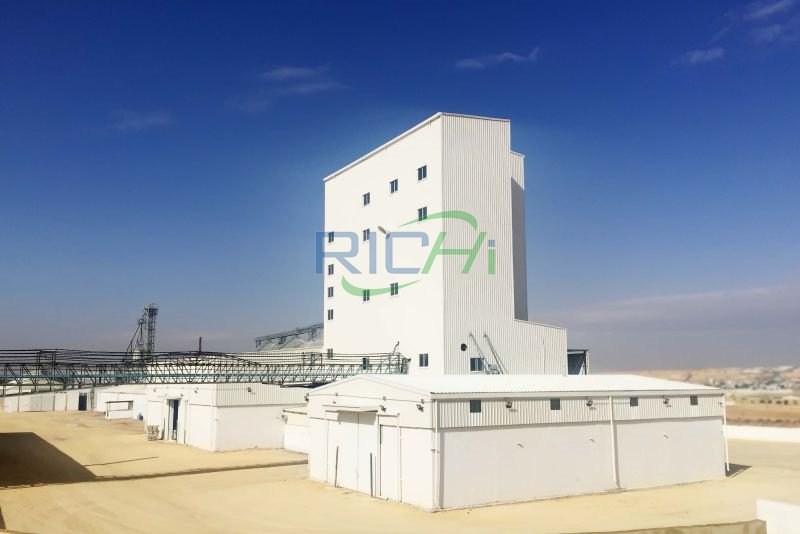In the competitive landscape of the animal feed industry, production efficiency is a critical factor that directly impacts profitability and sustainability. A 20 t/h animal feed processing machine is designed to meet the demands of medium to large-scale feed production operations, providing the capability to produce significant quantities of high-quality feed pellets. Understanding the factors that influence the production efficiency of such machines is essential for feed manufacturers aiming to optimize their operations. This article explores the key elements that affect the production efficiency of a 20 t/h animal feed processing machine.
1. Raw Material Quality
The quality of raw materials used in the feed production process plays a significant role in determining the efficiency of the machine.
- Moisture Content: The moisture content of raw materials affects their processing characteristics. Ideal moisture levels facilitate better conditioning and pelleting, leading to higher production efficiency. Materials with excessive moisture can cause clumping, while those with too little moisture may not pellet effectively.
- Particle Size: The particle size of raw materials is critical for achieving optimal feed quality. Finer particles generally allow for better mixing and conditioning, enhancing pellet formation. However, excessively fine particles can lead to increased friction and energy consumption during pelleting, potentially reducing efficiency.
- Ingredient Composition: The nutritional composition of the raw materials also impacts production efficiency. Ingredients with higher starch content tend to gelatinize better during conditioning, improving pellet quality. Understanding the nutritional profile of the raw materials helps in formulating effective feed recipes that enhance production efficiency.

2. Machine Design and Technology
The design and technology of the 20 t/h animal feed production machine significantly influence its production efficiency.
- Pelleting Technology: The type of pelleting technology used, such as ring die or flat die, affects the efficiency of the pelleting process. Ring die pellet mills are generally more efficient for larger production volumes, providing better pellet quality and reducing energy consumption.
- Conditioning Systems: Advanced conditioning systems that incorporate steam and moisture control can enhance the gelatinization of raw materials, leading to improved pellet quality and production efficiency. Proper conditioning ensures that the materials are adequately prepared for pelleting, reducing wear on the machine and enhancing output.
- Automation and Control: Modern feed processing machines often feature automation and control systems that monitor and adjust various parameters in real-time. These systems can optimize feed flow rates, temperature, and pressure, ensuring consistent production and minimizing waste.
3. Operational Practices
Effective operational practices are essential for maximizing the production efficiency of a 20 t/h animal feed processing machine.
- Regular Maintenance: Routine maintenance is crucial for ensuring that the machine operates at peak efficiency. Regular inspections, lubrication, and replacement of worn components help prevent unexpected breakdowns and maintain consistent production levels.
- Operator Training: Well-trained operators are key to maximizing production efficiency. Training programs that focus on machine operation, troubleshooting, and maintenance can empower operators to identify and address issues quickly, reducing downtime and enhancing output.
- Monitoring Performance: Implementing performance monitoring systems allows feed manufacturers to track key performance indicators (KPIs), such as output rates, energy consumption, and pellet quality. Analyzing this data helps identify trends and areas for improvement, enabling manufacturers to make informed decisions that enhance efficiency.
4. Energy Efficiency
Energy consumption is a significant factor in the overall production costs of feed manufacturing. Enhancing energy efficiency can lead to substantial cost savings and improved profitability.
- Energy-Efficient Motors: Using high-efficiency motors in the feed processing machine can reduce energy consumption while maintaining output levels. Investing in energy-efficient technology can lead to long-term savings on electricity costs.
- Optimized Process Flow: Streamlining the production process to minimize energy loss is essential. This can include optimizing the layout of the production line, reducing the distance materials must travel, and ensuring that equipment operates at optimal speeds.
- Heat Recovery Systems: Implementing heat recovery systems can capture excess heat generated during the pelleting process and reuse it for conditioning or other purposes. This not only improves energy efficiency but also reduces overall production costs.
5. Quality Control
Maintaining consistent quality in the final feed product is crucial for ensuring customer satisfaction and compliance with industry standards.
- Quality Assurance Protocols: Implementing quality assurance protocols throughout the production process helps identify and address issues that may affect pellet quality. Regular testing of raw materials and finished products ensures that they meet nutritional and safety standards.
- Adjusting Formulations: Based on quality control feedback, manufacturers may need to adjust feed formulations to optimize pellet quality and production efficiency. This adaptability allows for continuous improvement and responsiveness to market demands.
6. Conclusion
The production efficiency of a 20 t/h animal feed processing machine is influenced by various factors, including raw material quality, machine design and technology, operational practices, energy efficiency, and quality control measures. By understanding and optimizing these elements, feed manufacturers can enhance their production processes, reduce costs, and improve profitability.Investing in high-quality machinery, implementing effective maintenance and operational practices, and focusing on continuous improvement are essential strategies for maximizing the efficiency of animal feed production. As the demand for high-quality animal feed continues to grow, producers who prioritize production efficiency will be better positioned to succeed in this competitive market.
For details please contact: pellet press
WhatsApp:86 138 3838 9622
Email:enquiry@richipelletmachine.com

